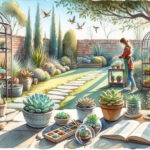Stepping into the World of Indoor Succulent Plants
Welcome! We’re about to explore the captivating realm of indoor succulent plants. If you’re craving a touch of greenery in your indoor space devoid of the great outdoors’ looming demands, then you’ve come to right place. Succulents are perfect for this role and have increasingly become the star of the indoor gardening show. But why is that so, you might wonder? Well, keep reading to uncover the appeal these quirky plants hold for indoor botany fans and aspiring green thumbs alike.
Understanding what Succulent Plants are
Succulent plants, also simply known as succulents, are plants with parts that are thickened, engorged, usually to retain water in the arid climates they grace. This feature not only ensures their survival in tough environments, but also lends them their distinct and alluring aesthetics. Featuring a wide range of shapes, sizes, colors, and textures, succulents can wonderfully spruce up any indoor space. But their allure goes beyond mere beauty!
Why Succulents are Popular for Indoor Gardening
The popularity of these indoor succulent plants is not a mere coincidence. Aside from their exotic appeal, they are incredibly easy to manage. A bit of sunlight, a sip of water, and voila – succulents thrive! How perfect for those of us who adore Mother Nature but don’t exactly have the greenest of thumbs, right?
The Underrated Value of Indoor Succulent Plants
Beyond their unique charm and low-maintenance nature, succulents bring along an even greater value: air purification. These indoor buddies are known for their excellent capability to purify the air by absorbing toxins and releasing oxygen. Now, isn’t that a refreshing breath of fresh, clean air?
Transforming Spaces with Indoor Succulent Plants
Indoor succulent plants are also much celebrated for their ability to jazz up any nook and cranny. Whether it’s an office desk that needs a touch of life, a living room seeking some color, or a kitchen shelf begging for an artistic touch, a well-placed succulent can be all it takes. From tiny pots on window sills to grand green walls, the aesthetic possibilities with these plants are simply boundless!
So, are you ready to bring some indoor succulent plants into your life? Trust us, they will not only purify your air but will enrich your indoor aesthetics like nothing else. Welcome aboard and let’s embark on this amazing indoor succulent journey together!
Discovering Popular Types of Indoor Succulent Plants
Now that we’re familiar with general succulent upkeep, let’s dive into exploring some popular types of indoor succulent plants. Each of these uniques species not only displays a distinct appearance but carries its own fascinating set of characteristics. Buckle up, green thumbs, we’re dipping our feet into the diverse world of succulents!
Aloe Vera (Aloe Barbadensis)
First up, we have a familiar crowd-pleaser, the Aloe Vera. Often adorning kitchen windowsills, this indoor succulent plant is easily identified by its lush green leaves fanning out from the center. Not only is it eye-catching, but it’s also practical. Got a minor burn? Snip off a chunk of Aloe Vera, and you’ll instantly get cooling, soothing relief.
Jade Plant (Crassula Ovata)
Next in line is the Jade Plant, also known as Crassula Ovata. An indoor succulent with a flair for the dramatic, Jade Plants are distinguished by their glossy, thick green leaves, often compared to beautiful jade gemstones. Perfect to brighten up darker corners with its distinctive silhouette, Crassula Ovata also brings good luck according to some cultures, making it a wonderful housewarming gift!
Burro’s Tail (Sedum Morganianum)
Hang around for a minute while we showcase the Burro’s Tail, or Sedum Morganianum. This indoor succulent plant is our top pick for creating vertical interest. With cascading, bead-like leaves that seem to pour out of the pot, you’ll soon be the envy of your friends. Due to its delicate nature, it’s best left in one spot where it can grow and trail to its heart’s content.
Crown of Thorns (Euphorbia Milii)
Now, let’s talk about the Crown of Thorns. Despite its grim name and sharp spines, Euphorbia Milii is a favorite among indoor succulent enthusiasts. Its resilience and profuse blooming nature make this indoor succulent plant a constant source of vibrancy throughout the year. What’s more, if cheerfully sunlight-soaked, Crown of Thorns rewards you with brilliant red blooms that provide a gorgeous contrast to its formidable stems.
Zebra Plant (Haworthia Fasciata)
Last, but certainly not least, we have the Zebra Plant, proudly sporting Latin alias Haworthia Fasciata. Recognizable by its thick, dark green leaves adorned with white ridges resembling zebra stripes, this indoor succulent plant is perfect for those searching for a compact, low-maintenance bit of greenery for their desks or bookshelves.
That rounds up our brief introductory tour of indoor succulent plants. Each species adds a vibrant touch of uniqueness to your indoor space. Mixing and matching these varieties can truly elevate your home decor and provide a vibrant, green sanctuary for you to relax in. And remember, these succulent companions aren’t just pretty – they’re sturdy, easy-to-care-for buddies that stick around for the long haul! Let us know what your favorite pick is, and happy planting!
Caring for Your Indoor Succulent Plants Like a Pro
We all love plants in our lives. They add a dash of calm, a sprinkle of color, and overall make any space more inviting. But let’s be real – not everyone was born with a green thumb. If you can relate, let us introduce you to your new best friends: indoor succulent plants. They’re hardy, they’re beautiful, and they bring that much-needed breath of fresh air to your indoor spaces.
So, whether you already have a lovely succulent collection or are thinking about starting one, let’s dive into the nitty-gritty of indoor succulent plants’ care. It’s simpler than you think!
Watering Your Succulents
First things first – watering. You might be tempted to water your succulents as you would any other plant – don’t! These tough little guys are used to desert conditions, meaning they prefer their soil on the dry side. A good rule of thumb (green or not) is to thoroughly water your succulents and then let the soil completely dry out before the next watering. Remember, overwatering is the quickest way to say goodbye to your succulents.
Sunbathing: Succulents Style
Next up, sunlight. Indoor succulent plants love bright, indirect light. In fact, the lack of sunlight can lead to etiolation, where your succulents start stretching out, looking for sun. Like us going for a tan, really. If you don’t have a brightly lit spot, worry not. These adaptable plants can thrive under fluorescent lights too. That’s why they are often found brightening up offices across the globe.
All about the Soil
Choosing the right soil type plays a crucial role in the care of your indoor succulents. Remember their desert origins? These plants prefer well-draining soil. Choose a mix made for cacti and succulents, or get creative and make your mix using regular potting soil, coarse sand, and perlite or pumice.
Maintaining the Ideal Temperature & Humidity
Temperature and humidity control also contribute to the success of your indoor succulent plants care. These plants prefer cooler nighttime temperatures of 50-55°F and daytime temperatures between 70-85°F. As for humidity, remember – desert origins. Keep it on the lower side, especially during the winter months.
So, there it is – a guide to indoor succulent plants’ care that won’t have you breaking sweats. Remember the key points – careful watering, ample indirect light, well-draining soil, and controlled temperature and humidity. With these in mind, you’ll be well on your way to creating your indoor desert oasis! And remember, every plant parent makes mistakes. But with succulents, they just keep hanging on as you learn the ropes. Now, go and rule that succulent kingdom!
Common Mistakes in Indoor Succulent Care and How to Avoid Them
Succulents are becoming an increasingly popular choice for indoor plants. Their hardy demeanor, vibrant colors, and quirky shapes make them an eye-catching addition to any interior decor. However, like any plant, indoor succulents need proper care to thrive. Let’s chat about some common indoor succulent care blunders, and how you can make sure your green friends stay healthy and happy.
Mistake 1: Overwatering Your Indoor Succulent Plants
Overzealous watering is a common misstep among new succulent parents. We agree, it’s hard to resist the urge to nurture our plant friends with copious amounts of water. But unlike most indoor plants, indoor succulents are adapted to survive in arid climates. They store water in their leaves, stems, and roots and overwatering can lead to waterlogging and root rot.
To avoid this, remember succulents live by the mantra less is more – less watering, that is. Use a well-draining soil, and water sparingly.
Mistake 2: Not Providing Enough Light
“Indoor” doesn’t equate to “low-light” in the succulent world. Don’t we all enjoy a bit of sunbathing? Well, so do your indoor succulent plants. Not providing them with enough light will lead to elongated and weak stems, and faded discoloration.
Avoid this mistake by placing your indoor succulents in a bright window where they’ll receive lots of indirect sunlight. If you’re short on windows, consider getting a grow light.
Mistake 3: Using The Wrong Soil
Your run-of-the-mill gardening soil won’t cut it for indoor succulents. They need a special, well-draining soil mix. Using bog-standard gardening soil can again lead to root rot due to water retention.
Solve this common indoor succulent care mistake by investing in a high-quality succulent or cactus mix. If you’re feeling DIY savvy, you could also try making your own blend.
Mistake 4: Neglecting Temperature and Humidity
Indoor succulents feel right at home in a wide range of temperatures but still prefer to steer clear of bitter cold and sweltering heat. Also, high humidity can spell trouble for your indoor succulent plants.
To prevent this, steer your succulents clear from drafty windows during winter, and blasting air conditioners or heaters. Consider a dehumidifier if you live in a high-humidity region.
Remember, your indoor succulent plants aren’t just decorative, they’re living organisms with specific needs. Paying attention to their watering, light, soil, temperature, and humidity needs will ensure they live a long and healthy life while adding a touch of green to your indoor space. Happy planting!
Decorating with Indoor Succulent Plants
The beauty of indoor succulent plants lies not just in their mesmerizing variety of shapes, sizes, and colors, but also in their ability to transform any living space into a stylish, eco-friendly oasis.
Now, we’ve all heard the basic advice: “Place your succulent on the windowsill for maximum sunlight.” Sound familiar? But there’s a whole wide world of interior design possibilities out there that can take your indoor succulent plant game to the next level.
Creative Planter Options for Your Succulents
Choosing a unique planter can bring an additional layer of charm to your succulents. For instance, for the individual who adores a rustic aesthetic, consider placing your indoor succulent plants in weathered wood planters or vintage cans.
On the other hand, if you lean towards a modern minimalistic look, sleek white cylindrical pots or geometric glass terrariums can highlight the architectural structure of your succulents. And for the whimsical at heart, there’s a world of fun and quirky containers like dinosaur-shaped planters, teacups, or even old books with cubbies carved into them!
Arrangement Ideas for Indoor Succulent Plants
Most succulents are incredibly accommodating and happy to share their space with different houseplants. Imagine an arrangement where a robust, rosette-shaped Echeveria is nestled between some slim Snake plants, with long-trailing String of Pearls cascading off the edge. Gorgeous, right?
Play around with different combinations of colors, shapes, and textures until you find a mix that delights your design sensibilities. The beauty of indoor succulent plants is their ability to add excitement and ambition to your living space.
Best Places to Display Succulents in Your Home
Indoor succulent plants don’t have to be confined to the windowsill! They can grace your coffee table as a captivating centerpiece or accent a dull bookshelf. You can even create a floating succulent garden with hanging planters, perfect for adding a dash of green to a blank wall.
Remember, bathroom environments are also ideal for certain species of indoor succulent plants that appreciate a little humidity, like the aloe vera or zebra plant.
Enhancing Your Space with Indoor Succulents
In the end, the goal is to use these charming plants to bring your space to life. There’s an indoor succulent plant for every taste, mood, and decorative whim, and discovering that perfect blend of planters, arrangements, and locations will create an inviting, stylish, and naturally breathable living space.
So take a close look around your home. Those corners, shelves, and even walls can become the perfect canvas for your indoor succulent plants masterpiece!
Benefits Of Having Indoor Succulent Plants
Living in a concrete jungle doesn’t mean we have to part ways with nature. The trend of keeping indoor succulent plants is gaining traction with city dwellers, and the reasons are numerous. These aren’t just aesthetic additions; they are tiny powerhouses offering tangible health benefits like improving indoor air quality, and even boosting mental wellbeing.
Revamp Your Indoor Aesthetics
Succulents, with their range of shapes, colors, and textures, are an interior designer’s dream. An architect might adore the vertical appeal of a skyward Sansevieria (Snake Plant), while a minimalistic enthusiast might fall in love with the understated simplicity of a Haworthia. Whizzing through an online plant nursery can indeed be like browsing through an art gallery, where each plant feels like a unique sculpture groomed lovingly by Mother Nature herself.
The Plant that Breathes in Reverse
Sure, we’d all love to have purer, cleaner air in our homes. Houseplants are often suggested to improve indoor air quality. However, most common houseplants, while respiring, release carbon dioxide (CO2) during the night, which isn’t ideal, particularly in a bedroom setting. But enter our all-rounder heroes – indoor succulent plants. They do it their own way using a process called CAM (Crassulacean Acid Metabolism) photosynthesis.
During the night, these plants intake CO2 and release oxygen, an attribute shared by few other houseplants. This makes succulents, like the Snake Plant or Aloe Vera, excellent additions to your bedroom decor.
Boost Your Mental Wellbeing
Imagine this: it’s been a stressful day at work. The moment you step into your home, you are greeted by your charming little succulent corner. A few minutes of tending to these beauties and you find your stress levels lowering. You are no longer just an overworked urban dweller, now you’re a gardener, a nurturer.
Research shows that interacting with indoor plants, like watering, pruning, or simply touching them, can effectively reduce stress and elevate moods. The tactile engagement acts as a form of biofeedback, bringing about a sense of calm and relaxation. Welcome to the world of ‘plant therapy’.
On a practical note, indoor succulent plants, with their low maintenance requirements, are way less stressful compared to most other houseplants. For those with a notorious brown thumb, tending to such easy-to-care plants can also help build plant confidence.
So, why not open your doors to these little show-stealers? They come with an irresistible appeal, boost your home’s indoor air quality and are natural stress-busters. Definitely a winning trio that fits snugly on your living room shelf or office desk!
Frequently Asked Questions
Indoor succulent plants have skyrocketed in popularity over recent years, and with good reason. These hearty little plants are a breeze to care for and they add a dash of natural beauty wherever they’re placed. Whether you’re a seasoned gardener or a self-proclaimed “black thumb”, you probably have a few questions about your leafy lodger. We’ve compiled some of the most frequently asked questions about indoor succulents for your convenience.
How Often Should I Water my Indoor Succulents?
First things first, let’s address watering. Too much love – that is, water – can be detrimental to your indoor succulents. This isn’t your grandmother’s philodendron that craves weekly soakings. Succulents are desert dwellers by nature; they’re built to withstand dry, arid conditions. The general rule of thumb here is to water your plant approximately once every 10-14 days. Remember, it’s always better to underwater than overwater when it comes to succulents.
What Type of Soil is Best for Indoor Succulents?
Your indoor succulent plants will thrive best in well-draining, gritty soil. Avoid using standard potting soil as it retains too much moisture, which can lead to root rot. Instead, opt for a succulent-specific potting mix. Experiences gardeners often make their own blend, combining regular potting soil with coarse sand or crushed granite to balance moisture levels.
How Much Sunlight Does an Indoor Succulent Need?
Indoor succulents love sunlight just as much as their outdoor siblings. While they don’t need a full day of glaring sun, they do require a good amount of indirect light. Placing them near a window that gets plenty of filtered sunlight is ideal. Lack of sunlight can cause your indoor succulent plants to become ‘leggy’, meaning they will grow tall and stretch towards the light, which can weaken the plant.
Do Indoor Succulents Need Fertilizer?
Fertilizer isn’t strictly necessary for indoor succulent plants, but it can give them an extra boost of nutrients, especially during their growing season. If you notice the colors fading or the plant lacking vitality, try using a diluted, balanced fertilizer every two weeks during spring and summer.
How Can I Propagate My Indoor Succulents?
Most indoor succulent plants are easy to propagate, which means you can generate new plants from your existing one. The method depends on the type of succulent, but common practices include leaf cuttings, stem cuttings, or simply dividing the plant at the root. Always let the cut areas dry out before re-planting to avoid disease and rot.
What Should I Do If My Succulent Gets a Disease or Pest?
No matter how meticulous your care, indoor succulent plants can fall prey to pests and diseases. Most common issues are root rot from overwatering, mealybugs, or fungal diseases. If you notice anything amiss with your plant, the first step is to identify the problem. Once diagnosed, consult a gardening expert or do some online research to find the best treatment.
In the happy world of indoor succulents, knowledge is key. Remember, these are just general guidelines. Each species may require slightly different care, so always research your specific variety. And as always, happy planting!



